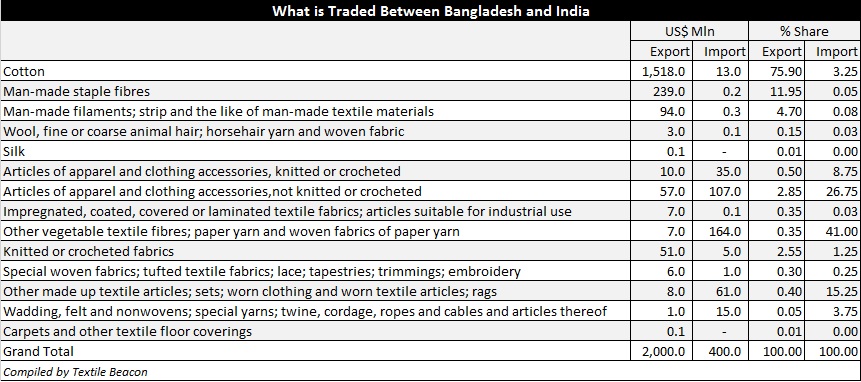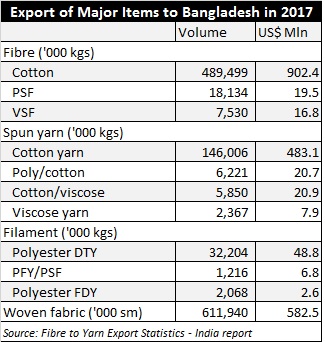Is Bangladesh India’s major textile trading partner
Bangladesh has been a major textile trading partner for India, with a share of more than 5% in exports and over 7% in imports. While annual textile exports to Bangladesh averages US$2,000 million, imports are worth US$400.
The major items of exports are fibre and yarn of cotton, man-made staple fibres and man-made filaments while major import items include apparel and clothing, fabric and other made up textile articles.
Exports to Bangladesh has been sluggish over the past 15 years, with some years seeing dramatic jumps but has slowed down in the past two-three years. Meanwhile imports have been rising in the corresponding period.
From the product-mix trade between India and Bangladesh, the latter imports raw material from the former and exports value added goods like fabric and apparel clothing to the world, including India. The textile industry in Bangladesh has been structurally developed to manufacture value added textile products, due to lack of raw material, which it relies on imports from surplus countries like India and USA.
India is the second largest supplier (16%) of textiles to Bangladesh, preceded only by China (35%) and followed by Hongkong (14%). For exports US, Germany and United Kingdom are the top destinations. India ranks 17th in terms of exports.
Textiles in Bangladesh
The textile and clothing industries in Bangladesh provide the single source of growth for its economy. Exports of textiles and garments are the principal source of foreign exchange earnings. By 2002, exports of textiles, clothing, and ready-made garments (RMG) had reached a proportion of 77% of it’s total merchandise exports. And as of 2016, Bangladesh held the 2nd place in producing garments just after China. Bangladesh is the world’s second-largest apparel exporter of western (fast) fashion brands. Nearly 60% of the export contracts of western brands are with European buyers and about 40% with American buyers. But only 5% of textile factories are owned by foreign investors, with most of the production being controlled by local investors. In 2016-17, the RMG industry generated US$28.14 billion, which was 80.7% of the total export earnings in exports and 12.4% of the GDP. Of late, to remain in competition, the industry was adopting green manufacturing practices.

Textile industry has been large developed under trade versus aid debate. The encouragement of the garment industry as an open trade regime is argued to be a much more effective form of assistance than foreign aid. Tools such as quotas through the WTO Agreement on Textiles and Clothing (ATC) and Everything but Arms (EBA) and the US 2009 Tariff Relief Assistance in the global clothing market have benefited ready-made garments industry. In 2012 the textile industry accounted for 45% of all industrial employment in Bangladesh yet only contributed 5% of the it’s GDP. After several fires and collapses of factory building, resulting in the deaths of thousands of workers, the textile industry and its buyers have faced criticism. Many were concerned with possible worker safety violations and were working to have the government increase safety standards. The role of women has been important in the debate as some argue that the textile industry has been an important means of economic security for women while others focus on the fact that women are disproportionately textile workers. Measures are being taken to ensure better worker conditions, but many can still argue for more to be done.
India’s exports to Bangladesh in 2017

In 2017, India’s shipment to Bangladesh including fibres, spun yarn, filament, woven and knitted fabrics totaled US$2,120 million. Of which, cotton export was worth US$900 million and spun yarns valued at US$580 million. Woven fabric exports totaled US$580 million. Among spun yarns, cotton yarn was the major item of export, followed by PC yarns, cotton viscose and viscose yarn.